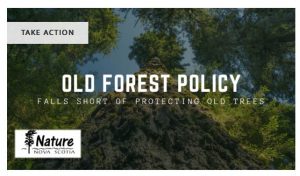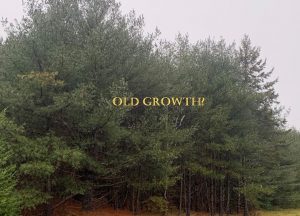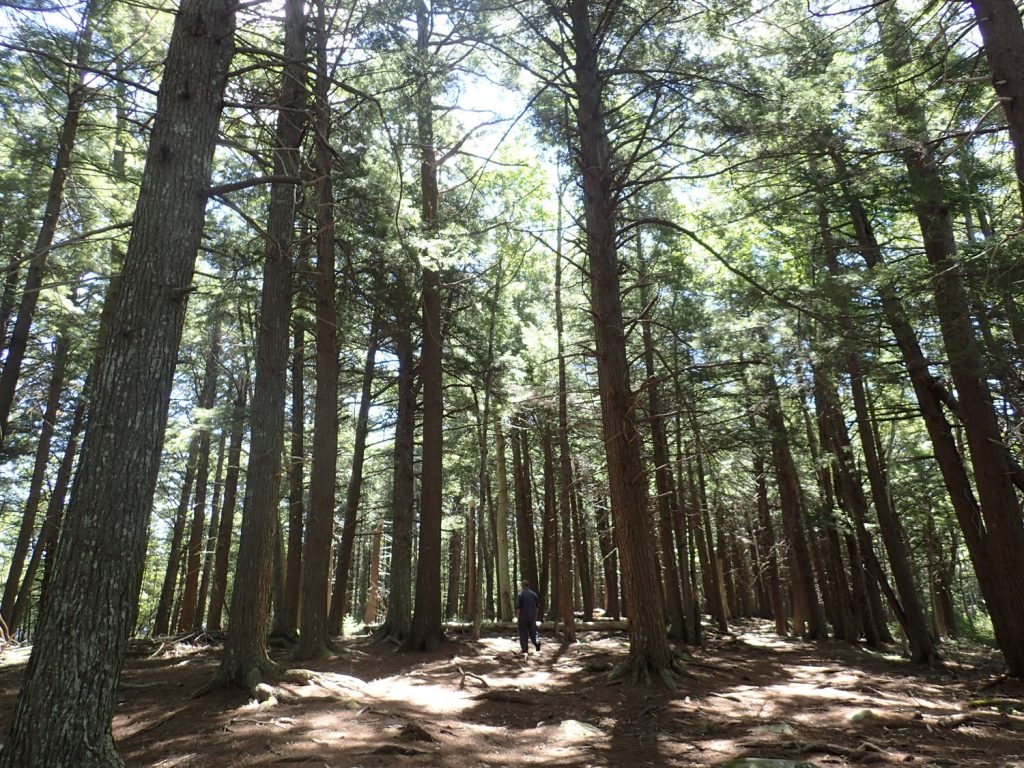From Nature Nova Scotia, Dec 1, 2021:
 Naturalists Respond to Draft Old Forest Policy Naturalists Respond to Draft Old Forest Policy
The Nova Scotia government released the draft “Old-Growth Forest Policy for Nova Scotia” last month, asking Nova Scotians to give their feedback on proposed updates. This would update the Old Forest Policy of 2012, which outlines a process and criteria for old forest protection. The document is long and technical, so we have provided a selection of responses from expert scientists, naturalists, and others involved in forestry, forest ecology, and conservation in the province, so that Nova Scotians can inform themselves on this important policy, and why it falls short. Key feedback included:
|
Posted on Giants of Nova Scotia (Facebook group) Dec 6, 2021
|
Longtime forest advocate Donna Crossland writes … This stand of ‘old growth’ white pine features a forest structure we do not expect to see when we think of old growth, yet it was included in the previous Old Forest Policy and we are left to assume it is part of the 8 % old growth in the new Old Growth Forest Policy. The government department entrusted to protect old growth — the Department of Natural Resources and Renewables (DNRR) — states that it has fully achieved 8 % protection of old growth in all ecodistricts across the Nova Scotia landscape. These white pines were planted during the late 1970s-early ’80s to restore an old field located at the entrance of Kejimkujik National Park and National Historic Site next to a helicopter landing pad. Old fields are difficult to return to natural forest condition, with soils that bear the mark of the farmer’s plough for centuries following agricultural abandonment, devoid of natural pit and mound topography and native biodiversity, and riddled with invasive earthworms that alter natural decay processes when they rapidly mix forest duff and incorporate leaf litter into the soil. It will likely take two centuries or more for it to resemble a natural forest, if ever achieved at all. Should this white pine plantation be considered part of the 8 % old growth? Would you rather see some other stands that much more closely resemble old growth included in the 8 % that are not currently protected? We have only until Wednesday, December 8th to submit comments on the revised ‘Old Growth Forest Policy’ by the DNRR. You may submit comments by email to ecologicalforestry@novascotia.ca. And with the criticisms by William Lahey last week over lack of genuine progress toward implementing a more ecological approach to forest management, you may wish to include sending your concerns to Minister of Natural Resources, Tory Rushton, mindnr@novascotia.ca. Minister Rushton is taking this week to consider how the government may respond to their lack of progress toward ecological forestry and continued clearcutting. ‘Mature climax’ trees are being harvested while the department claims to have protected a sufficient amount of old growth to answer biodiversity needs. Meanwhile this white pine stand on National Park lands has nothing to do with DNRR’s achievement or management of old growth. |
What should be our Goal for percent of Old Growth in NS? – We were given a well rationalized goal in 2003
In an previous post, I commented on the arbitrary nature of the goal of the ‘8% minimum in each ecodistrict.
I have just re-read Old-growth forests of the Acadian Forest Region by A. Mosseler, J.A. Lynds, and J.E. Major. Environmental Reviews 11: S47–S77 (2003), a very detailed and illuminating paper. (The full paper is available on request from the Canadian Forestry Service).
Mosseler et al., suggest we should aim for “20–25% of our forest be maintained in these late-successional OG forest types… perhaps 10–12% within protected areas and 10–12% within the working forest”.
From a section on Management Recommendations, p 568:
…Forest resource inventory data suggest that between 1% (Lynds and LeDuc 1995) and 5% (Anonymous 2002, Fig. 1) of Nova Scotia, and perhaps less than 2–3% of New Brunswick, exists as forest older than 100 years.
Based on the frequency of stand-replacing or catastrophic natural disturbances such as fire and wind in the AFR [Atlantic Forest Region], the length of time required to develop OG, and the areal distribution of temperate-zone forests in the AFR capable of developing these late-successional forest types, we estimate that 40–50% of the pre-settlement forested landscape may have been occupied by OG forest.
Although the question of how much area should be kept in OG forest types is largely an issue of social and economic policy, given our estimates of the extent of OG in the pre-settlement forest, it seems reasonable to suggest that at least 20–25% of our forest be maintained in these late-successional OG forest types*, perhaps 10–12% within protected areas and 10–12% within the working forest.
It is difficult to justify these amounts based purely on what science would prescribe as a minimum for maintaining a tree species according to population genetics theory. Our arguments for maintaining these amounts are based largely on our understanding of what might be necessary to maintain a viable metapopulation structure capable of continuous dispersal across a fragmented landscape in which the forest must adapt to anticipated rapid climatic changes.
Furthermore, the OG forest structure required to maintain the population viability of forest-dependent wildlife, such as the American marten, and some of the larger mammals that are endangered or have been extirpated in the Maritimes (wolves, eastern cougar, wolverine, lynx) requires much larger areas than that prescribed by population genetics theory for the trees themselves.
______________
*Age-wise, Mosseler defined late-successional, temperate-zone old-growth forest types as having “Average age of dominant species approaching half the maximum longevity for species (approximately 150+ years for most shade-tolerant trees)” and Some old trees at close to their maximum longevity (ages of 300+ years).


